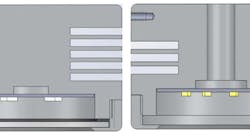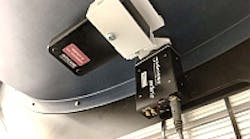In order to test LED devices against lumen maintenance standards, Lisun developed the LPCE-2 (LMS-9000A) high accuracy spectroradiometer and integrating sphere test tools. This test system meets the requirements of CIE, EN and LM-79 clause 9.1, as well as the requirements of LM-80. Based on the typical tests, Lisun’s engineers developed new software to meet the requirements of LM-80. So LPCE-2 has two software capabilities: one is to test the luminous flux, color temperature, color rending index, wavelength, spectrum, light efficiency, etc.; and the other is to test and record the data of lumen vs time. According to the data, we can generally predict LED life. But the main function for LED test tools is to evaluate the photoelectric and colorimetric parameters of LEDs, which is not a standard way to test LED life, so the test results and reports cannot be regarded as the final evaluation. But alongside developments in LED technology, Lisun has pushed the LEDLM-80PL LED lumen maintenance and lifetime test tools into the market; this system is designed according to LM-80-08, TM-82, TM-21 requirements, etc., so it completely meets all of these relevant standards.
LEDLM-80PL is developed based on the mature system of LPCE-2 (LMS-9000A). In the hardware, LEDLM-80PL still adopts a high accuracy CCD spectroradiometer to maintain high precision. And the most important is the software, which is the essence of the LPCE-2 test capability. Then it combines with the Arrhenius model to build a newly reliable LED lifetime prediction software. Users will only need to test the lamp for hundreds of hours under certain temperatures, then the software will calculate the time to 70% (50%, 30%) lumen maintenance at this temperature; it will greatly help to improve the test efficiency, accuracy, and reliability of LED lumen maintenance testing.
LEDLM-80PL is developed based on the mature system of LPCE-2 (LMS-9000A). In the hardware, LEDLM-80PL still adopts a high accuracy CCD spectroradiometer to maintain high precision. And the most important is the software, which is the essence of the LPCE-2 test capability. Then it combines with the Arrhenius model to build a newly reliable LED lifetime prediction software. Users will only need to test the lamp for hundreds of hours under certain temperatures, then the software will calculate the time to 70% (50%, 30%) lumen maintenance at this temperature; it will greatly help to improve the test efficiency, accuracy, and reliability of LED lumen maintenance testing.
Notes:
IESNA-LM-80 (Measuring Lumen Maintenance of LED Light sources) is an approved method by the Illuminating Engineering Society of North America (IESNA) for third generation solid-state lighting products; it covers the measurement standard and method. The main purpose is to set measurement methodology and records of the LED lumen maintenance changes with time -- in other words, it is applied to test LED aging life.
Compared with the traditional light source, theoretically LED lifetime can reach 50,000 hours. So it is hard to test LED lifetime, because it is impossible to light up the LED till it dies, and it is also unworkable because there are so many different types and different power of LEDs. If the problem cannot be solved, it will create resistance to development and adoption of LED products. Considering the real situation, IESNA passed the LM-80-08 approved method, which provides the guidance and specification for measuring and recording LED lumens vs time, and calculating the lifetime of LED luminaires in the end. Also it solves an urgent problem for the LED industry.
When we say LED lumen maintenance and LED aging life, we talk about LM-80, TM-21, TM-82, etc. so it is necessary to explain them. LM-80-08 put forward the measurement method and then obtains the data; TM-21 put forward the calculation method and then obtains the data. In those standards, L70, L50, L30, etc., means the time to 70% lumen maintenance, time to 50% lumen maintenance and time to 30% lumen maintenance. From the data, we can find lumens changing along with the time. Generally speaking, time to 70% lumen maintenance will be defined as the LED lifetime.
Compared with the traditional light source, theoretically LED lifetime can reach 50,000 hours. So it is hard to test LED lifetime, because it is impossible to light up the LED till it dies, and it is also unworkable because there are so many different types and different power of LEDs. If the problem cannot be solved, it will create resistance to development and adoption of LED products. Considering the real situation, IESNA passed the LM-80-08 approved method, which provides the guidance and specification for measuring and recording LED lumens vs time, and calculating the lifetime of LED luminaires in the end. Also it solves an urgent problem for the LED industry.
When we say LED lumen maintenance and LED aging life, we talk about LM-80, TM-21, TM-82, etc. so it is necessary to explain them. LM-80-08 put forward the measurement method and then obtains the data; TM-21 put forward the calculation method and then obtains the data. In those standards, L70, L50, L30, etc., means the time to 70% lumen maintenance, time to 50% lumen maintenance and time to 30% lumen maintenance. From the data, we can find lumens changing along with the time. Generally speaking, time to 70% lumen maintenance will be defined as the LED lifetime.
According to LM-80, the test time should be no less than 6000h, and 10000h is recommended. And during the test, temperature is limited at three points - first one is 55 degrees, second one is 85 degrees, and the third one depends on the manufacturer. And generally, the test report should include the following information: number of LED light sources tested, description of LED light source, description of auxiliary devices, operating cycles, ambient conditions including airflow, temperature and relative humidity, drive current of the LED light source during lifetime test, initial luminous flux and forward voltage at photometric measurement current, lumen maintenance data for each individual LED light source along with median value, standard deviation, minimum and maximum lumen maintenance value for all of the LED light sources, observation of LED light source failures including the failure conditions and time of failure, LED light source monitoring interval, photometric measurement uncertainty, and chromaticity shift reported over the measurement time.
Contact:
Mr. Sam Gan - Lisun+86-021-51083341-8002
E-mail:
[email protected]Web site:
www.lisungroup.comLocate more test & measurement equipment vendors in the LEDs Magazine Online Suppliers Directory
Submit new products, case studies/projects, and other press releases at http://www.ledsmagazine.com/content/leds/en/addcontent.html.




